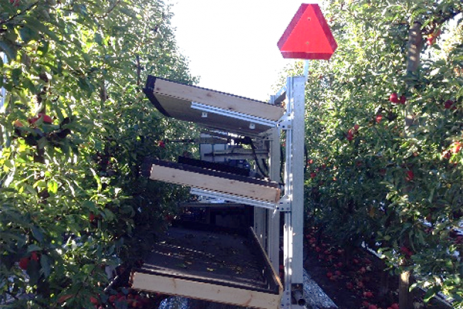Challenges in the tree fruit industry
During the past several decades, agriculture, in general, has made advancements as a result of automation and precision management technologies. However, for the specialty crops including tree fruit, the application of automation and precision management has lagged behind due to the complexity of orchard tasks and inconsistencies in orchard systems. The majority of tree fruit production operations are still highly dependent on human labor.
Furthermore, orchard operations are typically labor intensive and highly time sensitive. This intense labor demand is creating a significant risk of growers not having a sufficient supply of labor to conduct seasonal tasks. The industry needs technological innovations to assist growers in maintaining a competitive position in the global marketplace. Meanwhile, more food needs to be produced to feed a continuously increasing population with limited resources such as water and agricultural land. Precision agriculture has become essential to minimize production inputs and environmental footprints of agricultural systems.
Mechanization and automation for tree fruit production
To address the challenges in the tree fruit industry, innovative mechanical and automated systems are the solutions to reduce labor demand. In Pennsylvania, tree fruit orchards are increasingly planted in high-density systems that could allow easier access to both the tree canopy and fruits. This increases the potential for applying mechanical and automated technologies. A “Robot Ready” concept was proposed recently by Washington State University scientists to train and manage orchards for robotic harvesting. The horticultural advancement is very important for adopting mechanical or robotic technologies in tree fruit production.
Tall spindle “tree wall” system that is “Robot Ready.” Photo: Tara Baugher, Penn State
Most research on automated solutions for tree fruit production is focused on harvesting and pruning tasks. Take robotic apple harvesting as an example. FFRobotics in Israel and Abundant Robotics in California are racing to get their robotic pickers to market within the next couple of years. In addition to robotic arms, machine vision and navigation are two core technologies in the automation of tree fruit production. A machine vision system is used to detect and localize the fruits for robotic harvesting, and branch detection and reconstruction would be critical to robotic pruning and tree training. GPS navigation systems have been successfully used in tractors for various agricultural applications, including tree planting. Research has also been conducted to investigate the use of autonomous vehicles and platforms for human assist operations, such as pruning, semi-automated harvest, thinning, and training. Work efficiency has improved significantly in research trials comparing these platforms to ladders.
Although fully autonomous orchard technologies are still under development, some mass mechanization technologies are available for operations such as hedging of fruit trees and non-selective blossom thinning. Mass mechanical harvesting of fresh market apples is proving to be promising. We are involved in a grant proposal with California engineers to develop an integrated shake-and-catch harvesting platform for tree fruits. Compared to robotic systems, mass mechanization, while non-selective, typically has higher efficiency and is more cost-effective.
Mechanical peach blossom thinner commercialized as a result of multi-state research led by Penn State. Photo: Loy Elliott
Precision agriculture technologies for tree fruit growers
Precision agriculture is a farm management concept based on observing, measuring, and responding to inter- and intra-field variability in crops. The goal of precision agriculture research is to define a decision support system for whole farm management with the goal of optimizing returns on inputs while preserving resources (Wikipedia). Precision agriculture has been widely used in field crops, and it is attracting more and more interest from researchers and private sectors involved with tree fruit crops. The involvement from tree fruit growers will be critical for the successful implementation of precision agriculture technologies.
Remote sensing is one of the most critical technologies for precision agriculture. There are two types of remote sensing systems—one is ground-based, and the other is aircraft-based. Remote sensing systems can provide quantitative data for decision-making for crop growth and field operations. It began with sensors for soil fertility and has quickly diversified to include satellite, aerial, and hand-held or tractor mounted sensors. Remote sensing has been applied to many aspects of crop monitoring, such as crop vegetation, soil moisture, canopy water stress, crop nutritional status and health, biomass and yield estimation, weed detection, and many more.
The use of small Unmanned Aerial Systems (sUAS) has recently grown in agricultural domains due to their decreasing costs, maneuverability, and ability to tackle multiple types of missions. We strongly believe that research and application of precision technologies with UAS have great potential for PA tree fruit operations. Sensors and data analytics related to UAS are critical to the application of remote sensing in agriculture. Sensors include digital RGB cameras, multispectral and hyperspectral cameras, thermal sensors, and Lidar sensors, which can be used to monitor various aspects of crop production. For example, digital RGB cameras are mainly used for field scouting and canopy coverage; thermal sensors are usually used for irrigation-related information such as soil moisture and crop water stress. With advanced research in commercial orchards, the use of UAS-based precision agriculture could improve tree fruit crop production in many ways.
Illustration of remote sensing in an orchard (ground-based and UAS-based).
FREC researchers will focus on developing and transferring technologies in mechanization, automation, and robotics for tree fruit crops. Some of the major topics in this area include harvesting, branch pruning, tree canopy training, and robotic orchard platform design. Various technology components will be included in these topics, such as intelligent sensing and machine vision systems, mechanical systems, mechatronic systems, robotic manipulators, robotic end-effectors, and automatic controllers.
Precision agriculture and decision support
FREC researchers will continue to conduct research activities in developing precision agriculture-related technologies including precision and automated irrigation systems, sensor decision support for orchard operations, and in-orchard wireless sensor networks for crop stress and health management.
– Tara Baugher and Long He, Ph.D, Penn State University















